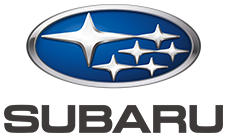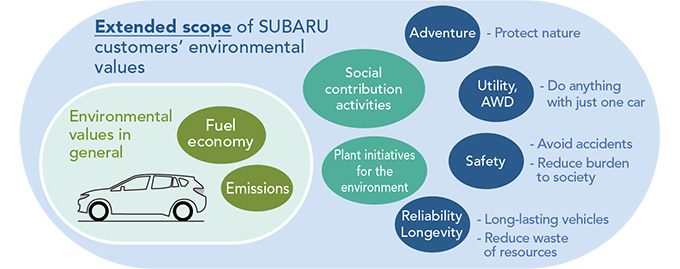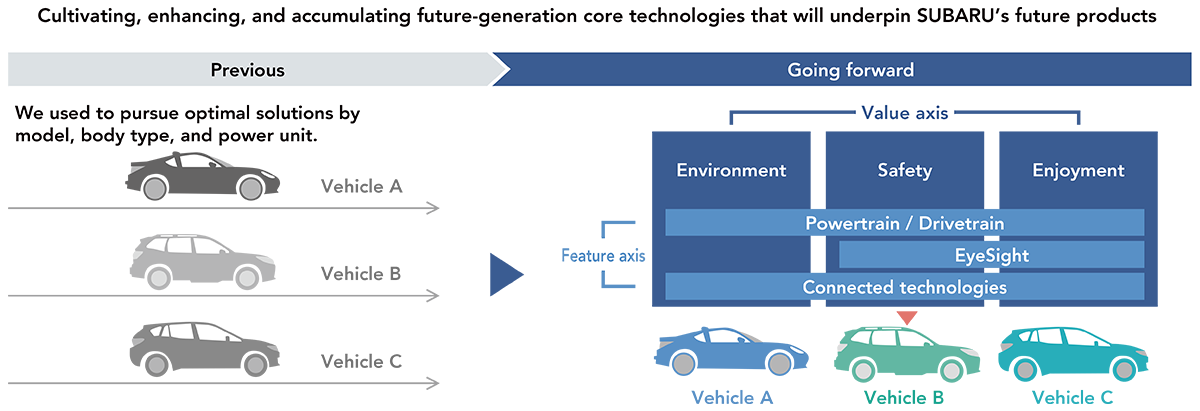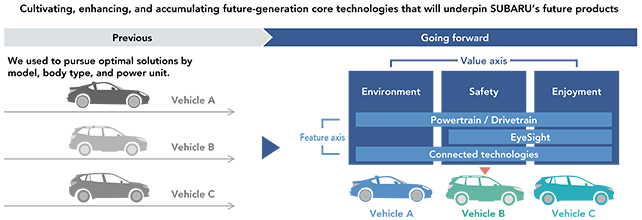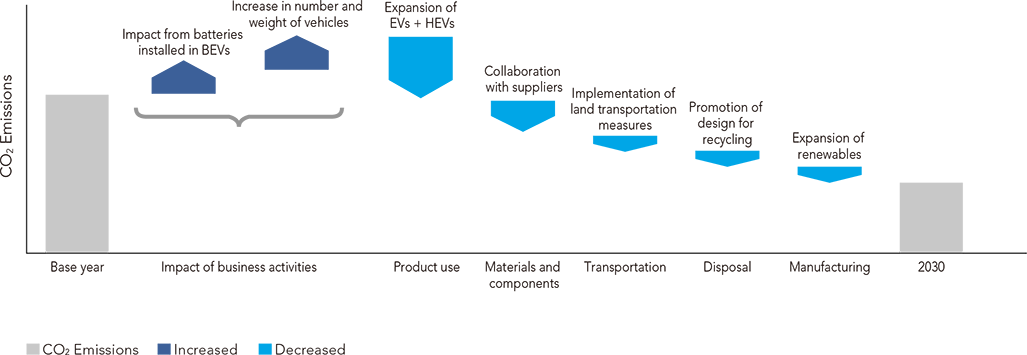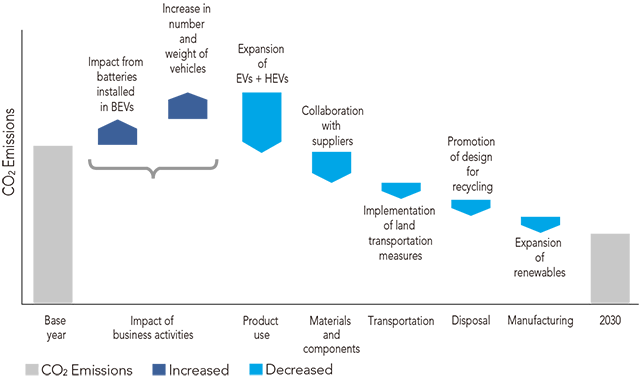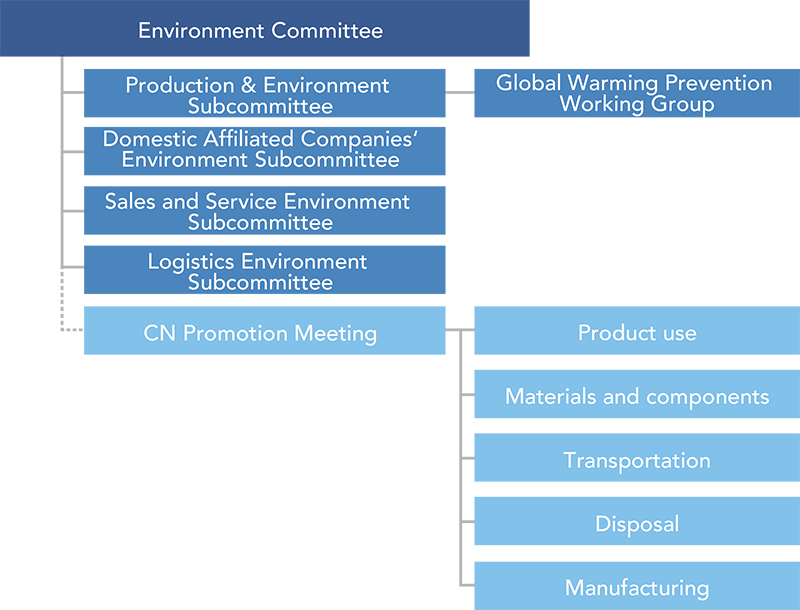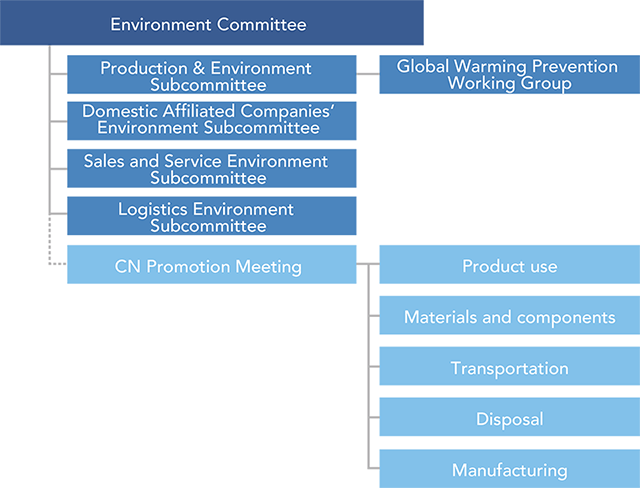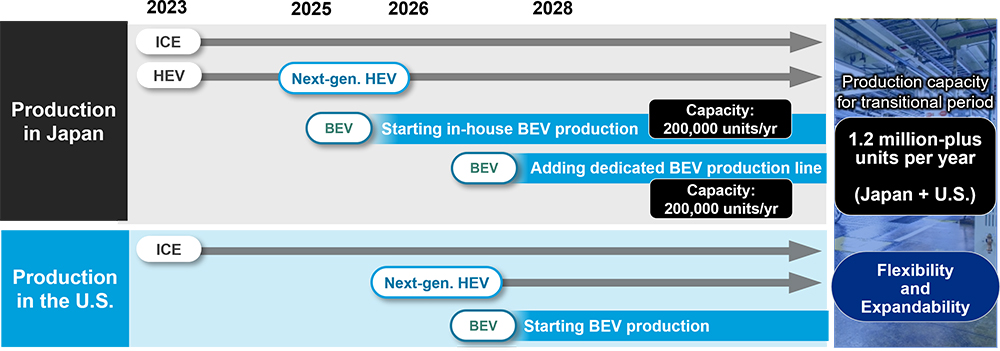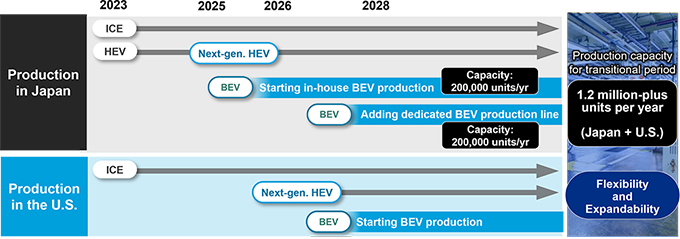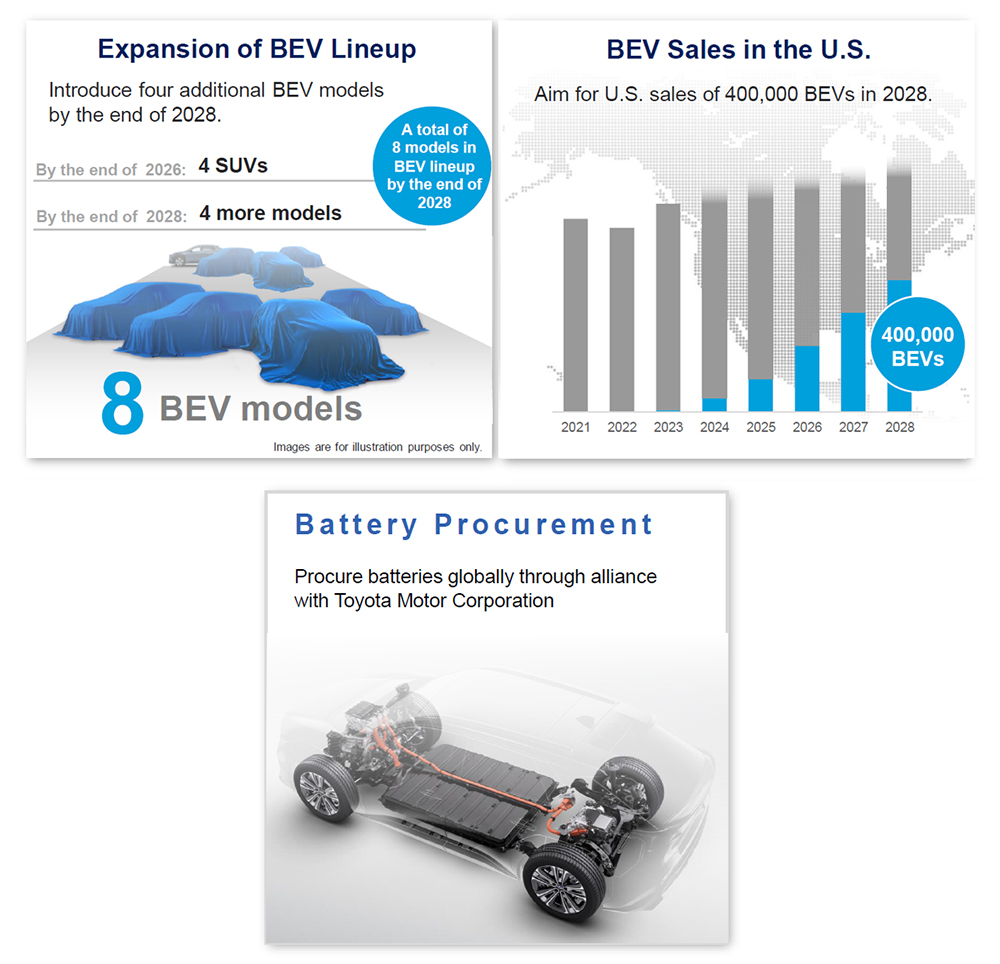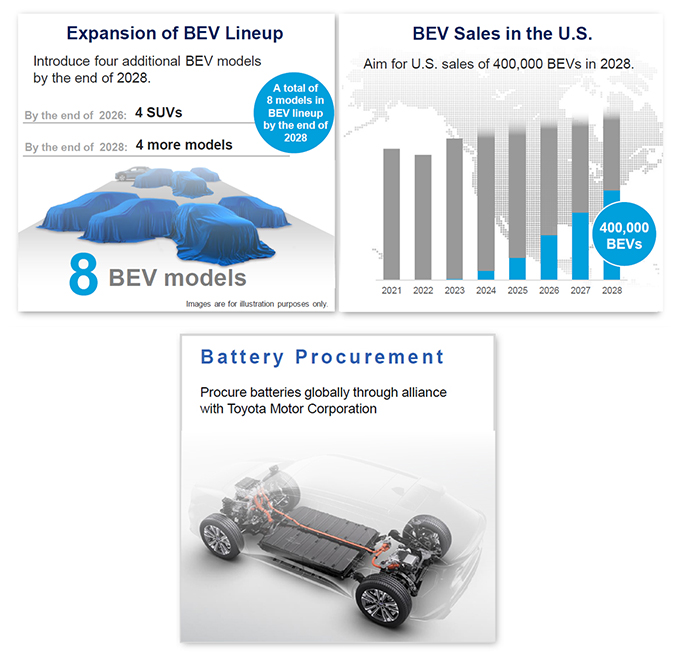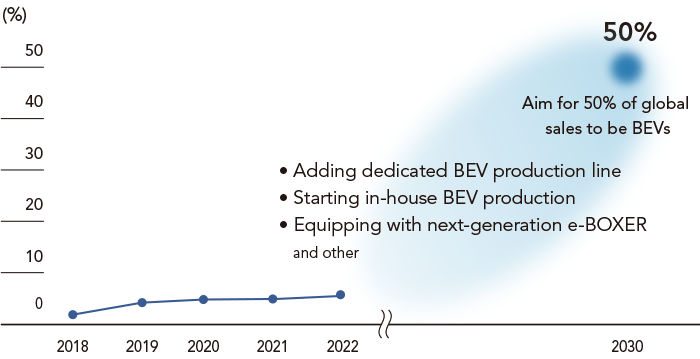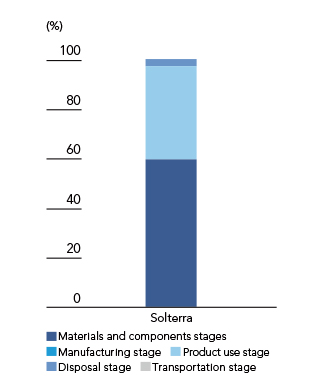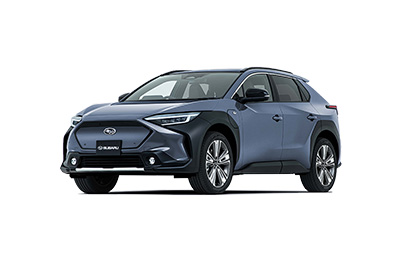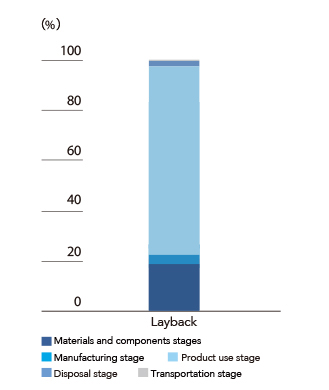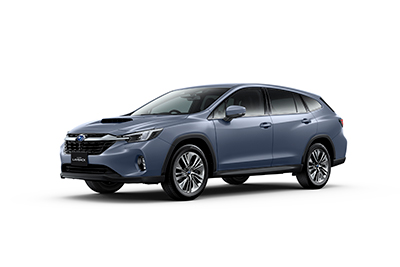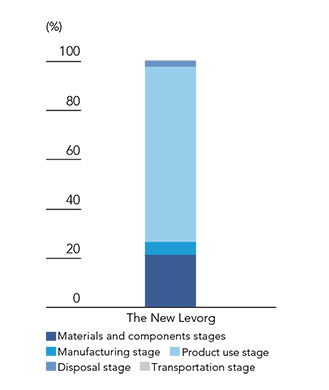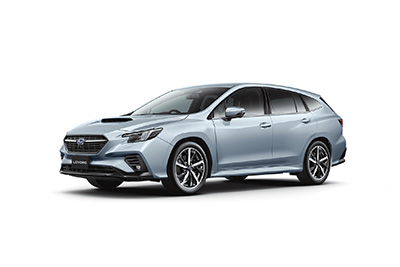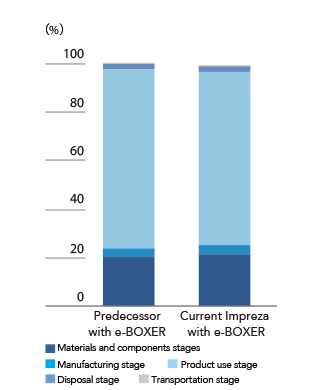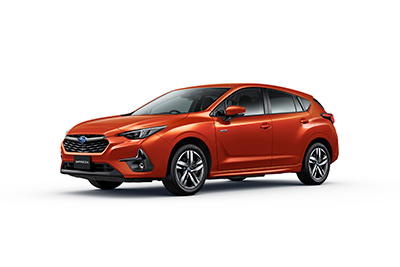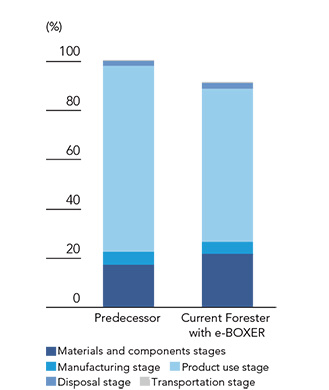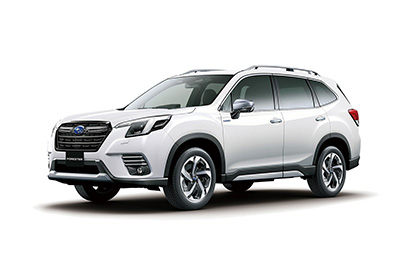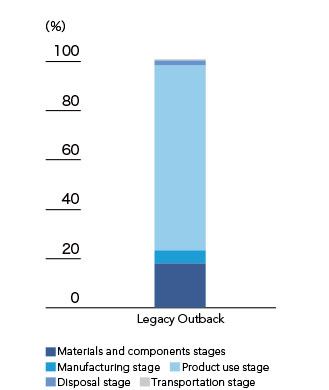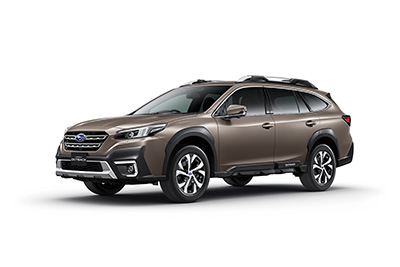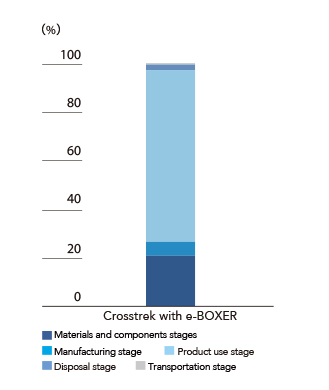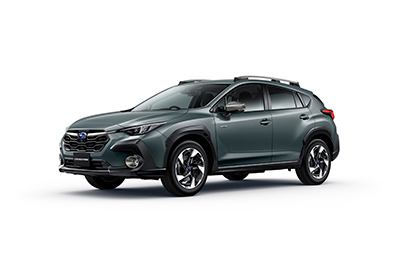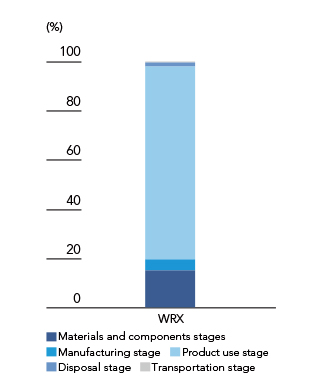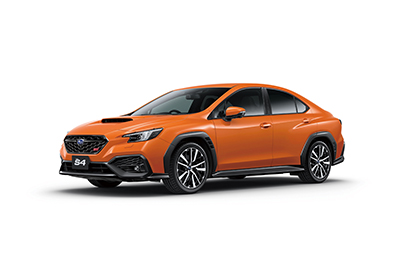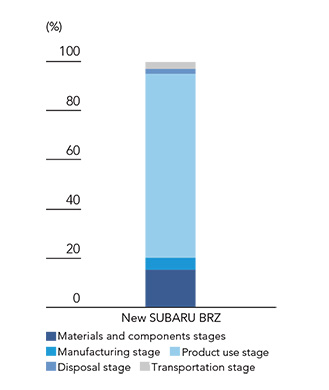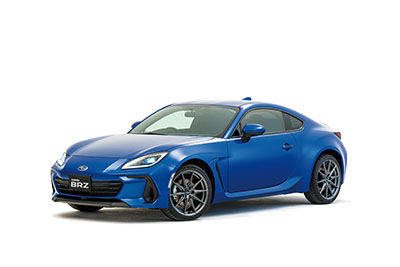Environmentally Friendly Automobiles
- Our Approach
- Management System
- Medium- to Long-Term Goals (Long-Term Vision and Milestones)
- Strategy for Transition Risks
- Strategic reorganization of domestic production
- Initiatives
- (Efforts to Reduce CO2 Emissions for New Models)
- (Life Cycle Assessment)
- (Design for Recycling)
- (Reducing Environmentally Hazardous Substances)
Our Approach
The environment surrounding our business is rapidly changing, and we believe we have entered an era where stakeholders not only question our business performance but also our corporate posture and raison d’être, such as how we contribute as a company to decarbonization and the realization of a sustainable society. Particularly in the U.S., an important market for SUBARU, we have found that there is a generally high level of awareness about global resources and society among our customers. They do not see environmental value in the usual sense—a vehicle’s fuel efficiency, emissions, or size—but instead recognize it in a broader sense, including the three elements of our “Enjoyment and Peace of Mind” value: that our utility and AWD vehicles allow them to do anything with just one car; that our safety causes fewer accidents and no problems for society; and that our reliability and longevity makes them useful over long periods of time and do not lead to wasted resources.
In promoting our electrification strategy, we at SUBARU believe that the most important thing is to assess the convenience of BEVs from a range of perspectives. This includes changes in markets and regulations, as well as changes in customer needs, preferences, and values, plus social infrastructure, while also striving to ensure a high level of financial soundness. Based on this concept, SUBARU will continue to develop products that satisfy customers and bring them happiness in order to meet their expectations and continue to be a brand that is “different.” We will also develop a flexible production system that incorporates the state of the market environment and manufacture environmentally friendly vehicles.
In addition, “the earth, the sky and nature” are SUBARU’s fields of business, and we truly do value the benefits nature provides. The SUBARU Group is committed to increasing the environmental performance of its products and also to protecting the global environment throughout the life cycle of its products, including product use, materials and components, transportation, disposal, and manufacturing.
Management System
We need to effectively invest resources in the development of strategic technologies and link technology and management more comprehensively. This will enable us to address new technologies, as symbolized by the EVs that will be key to resolving environmental issues, autonomous driving, and connected car services, which in turn will enable us to deliver appealing products.
SUBARU has therefore transitioned to a development system that organically combines value and function from a development system based on functional units such as vehicle bodies and power units in order to accelerate the development of new technologies such as environmentally responsible EVs. In this system, we are integrating relevant departments and newly establishing departments connected to battery development. In addition, from April 2023, the Chief Technology Officer (CTO) and CTO Office were spun off from the Engineering Management Division to help them establish technology strategies in an environment with a reasonable distance from the execution of business and from a position closer to management. This is also to facilitate strategic planning not only for future technologies but also for manufacturing, procurement, and other overall car-making activities.
Our objective is to empower a transformation to a Group-wide optimization perspective over a division and vehicle optimization perspective within an organization that is flexibly able to address the technologies of the future. Our development system will evolve into a core platform for creating and delivering environmental and technological value that demonstrates SUBARU-ness.
Establishing a development system for cultivating, enhancing, and accumulating future-generation core technologies that will underpin SUBARU’s future products
In addition, in order to contribute to the realization of a decarbonized society through the reduction of CO2 emissions throughout the life cycle of our business activities, SUBARU has designated departments in charge of the five areas of “product use,” “materials and components,” “transportation,” “disposal,” and “manufacturing.” We now also hold monthly CN Promotion Meetings, bringing together representatives from the relevant departments in each area. In these CN Promotion Meetings, members share information from each area, formulate a master plan from a medium- to long-term perspective, and visualize the transition of emissions in each area in the interest of achieving carbon neutrality by 2050.
Approach to CO2 emissions reduction from an LCA perspective
Governance Structure for Climate Change
Medium- to Long-Term Goals (Long-Term Vision and Milestones)
In order to contribute to a decarbonized society, SUBARU has set long-term goals (long-term vision) for reducing CO2 emissions and medium-term goals (milestones) to complement them.
In the era of the electric car, the business environment is characterized by rapid, disruptive change. In order to achieve our vision for 2050, we will review our intermediate milestones for 2030 as necessary to adapt to this environment, continuing to enhance the SUBARU Difference and work toward environmentally friendly car-making.
- On a well-to-wheel*1 basis, we will pursue our goal of reducing the average CO2 emissions from new vehicles (in operation) sold worldwide by at least 90%*2 by 2050, compared with 2010.
- In the early 2030s, all commercial SUBARU cars*3 will be equipped with electrification technology*4.
- In 2030, aim for 50% of global sales to be BEVs
Furthermore, we have set the target of proceeding with research and development with the goal of using recycled materials*5 for more than 25% of the plastics used in new models*4 released worldwide by 2030 to help address the global waste plastic problem. To achieve this target, we are working to establish quality standards for recycled plastics and a raw material recovery scheme.
- *1
- Well-to-Wheel: Approach to calculating CO2 emissions including the emissions produced by the generation of electricity to be used by EVs and other vehicles.
- *2
- Reduce total CO2 emissions calculated based on the fuel efficiency (notified value) of all SUBARU automobiles sold across the world by 90% or more compared 2010 levels by 2050. Changes in the sales quantity due to changes in the market environment shall be taken into consideration, while minor changes in running distance shall not.
- *3
- Excluding models supplied by OEMs.
- *4
- Refers to the technology used to foster the use of electricity for EVs, HEVs, and others.
- *5
- Including material, chemical, and plastic recycling.
Strategy for Transition Risks
To address climate change-related transition risks in policy and regulation, technology, markets, and other items, SUBARU works to identify uncertain climate change-related risks. We also formulate our own scenarios and plans for achieving our medium- to long-term goals, based on policy trends in various countries and information published by the International Energy Agency and others that is specific to the scenario for reaching carbon neutrality by 2050 (equivalent to the 1.5°C scenario). These scenarios and plans are examined for compatibility with policies relevant to SUBARU.
Transition Risks Related to Business Management in General and Products
| Regulations | Business Management in General | Revisions to climate change targets in various countries could significantly impact our overall business. |
|---|---|---|
| Products | Failure to meet fuel economy regulations in various countries could result in additional costs or losses due to legal violations, or limit our opportunities to sell products. | |
| Technologies | Products | To promote electrification, it is crucial to ensure profitability for the entire product cycle ranging from procurement and use to disposal. Thus, it is essential to involve SUBARU’s upstream and downstream partners in exerting efforts toward this end. Failure to do this could render the Company unable to meet the profitability goal for the entire product life cycle. |
| Markets | Products | At present, it is difficult to make predictions with regard to electrification, which will likely cause a substantial gap with the real state of market needs. In such a situation, SUBARU could incur unnecessary and excessive R&D costs while facing a decline in customer satisfaction, resulting in unexpected losses and reduced sales opportunities as well as hampered advancement of the Company’s electrification efforts. SUBARU views electrification as a steady medium- to long-term trend. In the event of its swift and sweeping penetration of the market at some stage, SUBARU could be unprepared for such a prospect in terms of technology and timely product lineups, and thus suffer from a resultant loss of product sales opportunities. |
| Reputation | Business Management in General | Failure to implement adequate initiatives to achieve zero-carbon outcomes could have an adverse impact on recruitment and sales due to damage to brand value, and higher cost of capital due to difficulties in raising funds. |
Strategic reorganization of domestic production
In order to make environmental efforts with commitment to enhancing the SUBARU-ness and accelerate our roadmap toward 2050, SUBARU is implementing a strategic reorganization of its domestic production system. In this reorganization, it plans to invest 250 billion yen over five years starting from FYE March 2024. The production system reorganization targets two main goals formulated based on identified transition risks. These goals are to build a flexible system that can ensure production of internal combustion engine (ICE) vehicles and HEVs as needed during the transition to BEVs and to achieve efficient BEV production in the BEV business, where profitability remains an issue, in order to improve business potential.
As our roadmap for the domestic production system, we will launch in-house production of BEVs with a target start date around 2025, and gradually increase the number and models of BEVs produced. Furthermore, we are exploring the addition of BEV-dedicated production lines on or after 2027. At the Oizumi Plant, where we currently manufacture power units, the production of the next-generation e-BOXER* is planned for transfer to the Kitamoto Plant. This will be done to prepare for the transition to BEV production and to steadily make progress in installing the next-generation e-BOXER to multiple models. Preparations have begun to increase BEV production capacity at the Yajima Plant from 100,000 units per year, the initial plan, to 200,000 units by around 2026. Together with the newly launched Oizumi Plant, this is expected to bring domestic BEV production capacity to 400,000 units beginning in 2028. In conjunction with these increases, we have also begun exploring next-generation e-BOXER and BEV production in the U.S.
Here, we are building a production system that can dynamically adapt the production ratio between BEVs, hybrids, and ICE vehicles while keeping a close eye on environmental regulations and market trends. Simultaneously, these efforts will result in a production system founded in the concept of flexibility and scalability so that we can immediately scale production as soon as we can perceive future directions.
In addition to the Solterra, which was launched in 2022, we will launch three new BEVs to enhance the SUV category, an area where we have strengths, by the end of 2026. Furthermore, we will make efforts globally through our alliance with Toyota Motor Corporation for battery procurement to support the sales of these vehicles. We are also planning to add four more models to our BEV lineup by the end of 2028, aiming for sales of 400,000 units in the North American market in 2028.
In promoting our electrification strategy, we at SUBARU believe that the most important thing is to assess the convenience of BEVs from a range of perspectives. This includes changes in markets and regulations, as well as changes in customer needs, preferences, and values, plus social infrastructure. Based on this concept, SUBARU will continue to develop products that satisfy customers and bring them happiness. We will also continue to develop a flexible production system that incorporates the state of the market environment.
- *
- Generic term used for “horizontally-opposed engine + electrification technology,” which offers the unique driving pleasure of SUBARU while being environmentally friendly.
Strategic reorganization of domestic production
◼Respond to market changes by reorganizing the production structure based on the "flexibility and expandability" policy.
◼Start production of BEVs and the next-generation HEVs in the U.S.
The percentage of SUBARU’s EVs as a share of global sales in FYE March 2023 was 5.7%. However, we will grow our earnings base in the BEV era by strengthening our supply capacity for EVs, including the start of in-house BEV production in the mid-2020s in conjunction with the reorganization of our domestic production system, the launch of the next-generation e-BOXER, and the addition of dedicated BEV production lines in the late 2020s. As we do this, we will work to ensure a high level of financial soundness, taking actions in a sustainable structure toward our stated goal of aiming for 50% of SUBARU global sales to be BEVs in 2030.
Results and future plan of percentage of EVs sold (retail sales basis)
Initiatives
Efforts to Reduce CO2 Emissions for New Models
SUBARU is naturally working to improve the fuel efficiency of gasoline engine vehicles while turning its attention to expanding its lineup of EV models, especially the development and supply of BEVs. We believe it will be especially important to steadily promote the expansion of the above initiatives in order to reduce the amount of CO2 emitted from automobiles.
Battery Electric Vehicles (BEVs)
In May 2022, SUBARU launched the Solterra as another step toward the era of the electric car. Its first global BEV, the Solterra is designed to achieve coexistence with nature. It utilizes the e-SUBARU Global Platform, a dedicated EV platform we jointly developed with Toyota Motor Corporation (“Toyota”), as well as the AWD technology we have developed for many years and Toyota’s outstanding electrification technology, thus bringing together the strengths of both companies and efficiently leveraging our development investments. In addition to the Solterra, we plan to launch three new BEVs to the SUV category by the end of 2026. Like with our existing vehicles, we will bring SUVs featuring the unique appeal of SUBARU’s BEVs to Japan, the U.S. and Canada, Europe, China, and other markets, aiming to further strengthen the value we offer with the goal of being a brand that is “different” from others. We are also planning to add four more models to our BEV lineup by the end of 2028.
At SUBARU, we will continue to help protect the environment as we consider practical functions and customer preferences in enhancing our lineup in the markets we serve with environmentally friendly vehicles that are unique to SUBARU.
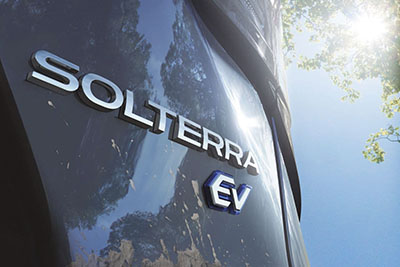
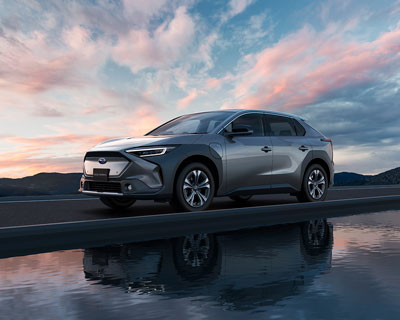
“Solterra” is a coined word that combines the Latin words “sol,” which means “sun,” and “terra,” which means “earth.”
Hybrid Electric Vehicles (HEVs)
SUBARU has been increasing the number of vehicles equipped with its mild hybrid e-BOXER engine that combines a horizontally-opposed engine and electrification technology, and to reduce CO2 emissions has implemented initiatives such as creating its own PHEV using HEV expertise from Toyota. In addition, looking ahead to 2025, we will begin next-generation e-BOXER production that incorporates THS*1 technology to deliver vehicles that feature the SUBARU-ness while offering high-level environmental performance. By steadily expanding our product lineup of EVs, we will help reduce CO2 emissions for new models.
- *1
- THS: TOYOTA Hybrid System
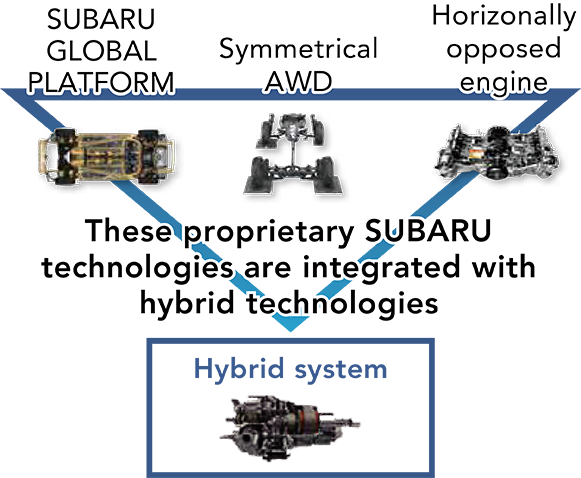
Gasoline-Powered Vehicles
We will continue to meet demand for conventional gasoline-powered vehicles from customers. HEVs, which we are expanding to include more models, are made by combining gasoline engines with electrification technology, and engines need further technological improvements to boost fuel efficiency. The 1.8-liter BOXER DIT*2 combines the unique driving pleasure of a SUBARU with outstanding environmental performance. Installed in the Levorg, Forester, and Outback models, it is a next-generation BOXER engine with a turbo system that generates high torque at low RPM. Its lean combustion technology produces more energy with less fuel. Combined with the expanded Lineartronic shift range, this engine offers even more powerful acceleration off the line and superb fuel efficiency when cruising at high speed. In addition, SUBARU is continuing to pursue the potential offered by engines in the era of carbon neutrality by participating in races with vehicles that use carbon-neutral fuel, as well as participating in the Research Association of Biomass Innovation for Next Generation Automobile Fuels.
- *2
- Direct injection turbo
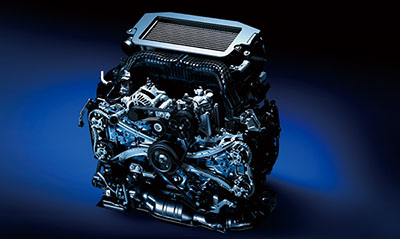
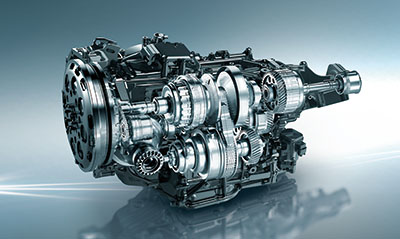
Research Association of Biomass Innovation for Next Generation Automobile Fuels
SUBARU, together with ENEOS Corporation, Suzuki Motor Corporation, Daihatsu Motor Co., Ltd., Toyota Motor Corporation, and Toyota Tsusho Corporation, established the Research Association of Biomass Innovation for Next Generation Automobile Fuels to research efficiency improvements in processes to produce fuel. Currently, seven companies, including Mazda Motor Corporation, are participating in this association to advance technological research on the use of biomass and efficient production of bioethanol fuel for automobiles in order to realize a carbon-neutral society.
Life Cycle Assessment
SUBARU conducts LCA*3 to evaluate CO2 emissions during the entire life cycle of automobiles. We will quantify the environmental impact of automobiles and proactively develop automobiles taking into account the need for decarbonization from the design stage.
In addition, SUBARU has designated departments in charge of the five areas of “product use,” “materials and components,” “transportation,” “disposal,” and “manufacturing” as of FYE March 2022. We now also hold monthly CN Promotion Meetings, bringing together representatives from the relevant departments in each area. By operating a cross-organizational committee structure, SUBARU will further promote efforts to reduce CO2 emissions throughout the life cycle of our business activities.
- *3
- Life-cycle assessment (LCA) is an environmental impact assessment method that comprehensively evaluates environmental load at every stage of the life cycle of products and services from raw material procurement to production, use, disposal, and recycling. For SUBARU, assessments are for cars built for the Japanese market.
Solterra
In May 2022, SUBARU launched the Solterra, its first global BEV.
The ratio of CO2 emissions at each LCA stage is shown below.
Layback
The ratio of CO2 emissions at each stage of the LCA for the Layback announced in October 2023 is shown below.
Levorg
The displacement class of the new Levorg announced in October 2020 has changed.
The ratio of CO2 emissions at each LCA stage is shown below.
Impreza
The ratio of CO2 emissions at each stage of the LCA for the new Impreza (e-BOXER) announced in April 2023 is shown below.
It reduces CO2 emissions by 2.4% over its life cycle compared with its e-BOXER predecessor.
Forester
LCA of the new Forester announced in June 2018 is shown below.
It reduces CO2 emissions by 8.7% over its life cycle compared with its gasoline-fueled predecessor.
Legacy Outback
The ratio of CO2 emissions at each stage of the LCA for the new Legacy Outback announced in October 2021 is shown below.
Crosstrek
The ratio of CO2 emissions at each stage of the LCA for the new Crosstrek announced in December 2022 is shown below.
WRX S4
The ratio of CO2 emissions at each stage of the LCA for the new WRX S4 announced in November 2021 is shown below.
SUBARU BRZ
The ratio of CO2 emissions at each stage of the LCA for the new SUBARU BRZ announced in July 2021 is shown below.
The displacement class is different from the predecessor model, so only data for the new model is presented.
Design for Recycling
SUBARU incorporates recyclability into its automobile design process to make effective use of limited resources.
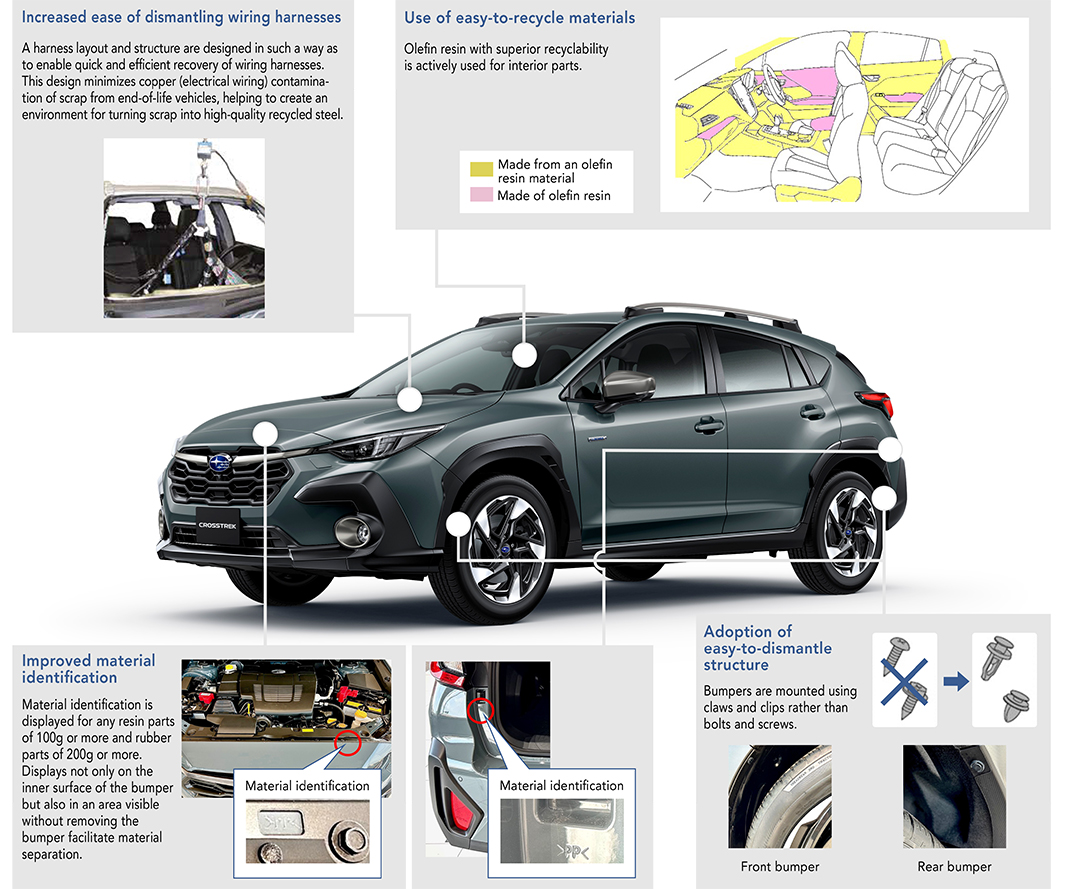
Utilizing Recycled Resins
To contribute to realizing a resource-recycling society and a decarbonized society, SUBARU is working to develop technologies to utilize recycled resins and biomass materials in place of the resins currently used in automobiles.
SUBARU recycles and uses scrap materials generated in supplier processes for the undercarriage covers of the new 2023 Crosstrek and Impreza.
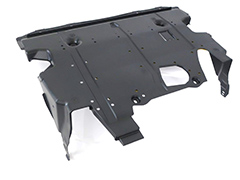
Subaru of America, Inc. helped develop and launch environmentally friendly accessories in the form of floor mats made from used recycled materials for the 2021 Crossstrek Sport®. The surface and lining of these floor mats are made from 100% post-consumer recycled (PCR) materials, such as marine waste. In addition, the company has introduced and utilizes a new supplier assessment system using ISO 14001.
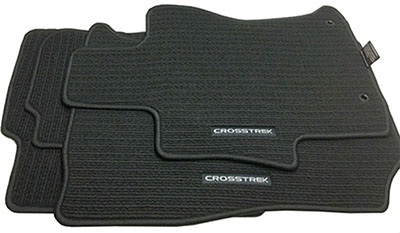
Reducing Environmentally Hazardous Substances
SUBARU is also collaborating with suppliers in reducing the use of environmentally hazardous substances in automobiles.
We continuously achieve the environmentally hazardous substance reduction targets for lead, mercury, hexavalent chromium, and cadmium set by Japan Automobile Manufacturers Association, Inc. (JAMA) for all new models released in and after 2008. Furthermore, in order to ensure compliance with the REACH regulation, ELV Directive, Chemical Substance Control Law, and other regulations enforced across the world, we are further reducing the use of lead and replacing phthalic acid-based plasticizer and chlorinated flame retardant and other hazardous chemical substances with alternatives.
Cleaner Exhaust Gas
To achieve and maintain clean air across the globe, SUBARU is developing technologies for cleaner exhaust gas, targeting not only conventional air pollutants such as hydrocarbon compounds and nitrogen oxides but also particulate matter, which is feared to have serious impacts on human health. At the product level, we are expanding our range of models that meet the latest regulations by country, while addressing emerging regulations at the development level.
- Japan: 2018 low emissions standards
- U.S.: State of California’s SULEV standards
- Europe: Euro 6 emission standards (final stage)
- China: China 6 emission standards
We will develop and propose reasonable products for customers based on the results of research conducted to identify the optimal specifications in each country, including research on the components of exhaust gas that will be regulated in the future. To this end, we are designing materials on an atomic level to improve the performance of the catalyst, which plays a major role in producing cleaner exhaust gas, while also reducing the use of precious metals.
Reducing VOCs*4 in Vehicle Interiors
SUBARU is reviewing the components and adhesive agents used in vehicle interiors in order to reduce the generation of volatile organic compounds (VOCs) in this area.
For the LEGACY, LEVOG, IMPREZA, FORESTER, and SUBARU BRZ,we have reduced concentrations of 13 substances defined by the Ministry of Health, Labor, and Welfare to levels below the indoor concentration guideline values (as revised in January 2019) and have achieved the voluntary targets of the JAMA*5. We will continue our efforts to reduce the levels of VOCs to make the in-vehicle environment even more comfortable.
- *4
- Organic compounds that easily volatilize at room temperature, such as formaldehyde and toluene, which are said to cause nose and throat irritation.
- *5
- Voluntary target set by JAMA in its “Voluntary Approach in Reducing Cabin VOC Concentration Levels,” which was announced with the intention of reducing the in-vehicle concentrations of the 13 substances designated by the Ministry of Health, Labour and Welfare to levels equivalent to or lower than the values set in the guidelines, for new models produced and sold in Japan in and after FYE March 2008. We will satisfy the revised indoor concentration guideline values by the Ministry of Health, Labour and Welfare for all new vehicles launched on or after 2022.
JAMA’s “Voluntary Approach in Reducing Cabin VOC Concentration Levels” (Japanese version only)
